�
FAQ
Colophon
Copyright © 2020-2022 Raspberry Pi Ltd (formerly Raspberry Pi (Trading) Ltd.)
The documentation of the RP2040 microcontroller is licensed under a Creative Commons Attribution-NoDerivatives 4.0
International (CC BY-ND).
build-date: 2022-06-17
build-version: 7028f9f-clean
About the SDK
Throughout the text "the SDK" refers to our Raspberry Pi Pico SDK. More details about the SDK can be
found in the Raspberry Pi Pico C/C++ SDK book. Source code included in the documentation is
Copyright © 2020-2022 Raspberry Pi Ltd (formerly Raspberry Pi (Trading) Ltd.) and licensed under the 3-
Clause BSD license.
Legal Disclaimer Notice
TECHNICAL AND RELIABILITY DATA FOR RASPBERRY PI PRODUCTS (INCLUDING DATASHEETS) AS MODIFIED FROM
TIME TO TIME (“RESOURCES”) ARE PROVIDED BY RASPBERRY PI LTD (“RPL”) "AS IS" AND ANY EXPRESS OR IMPLIED
WARRANTIES, INCLUDING, BUT NOT LIMITED TO, THE IMPLIED WARRANTIES OF MERCHANTABILITY AND FITNESS
FOR A PARTICULAR PURPOSE ARE DISCLAIMED. TO THE MAXIMUM EXTENT PERMITTED BY APPLICABLE LAW IN NO
EVENT SHALL RPL BE LIABLE FOR ANY DIRECT, INDIRECT, INCIDENTAL, SPECIAL, EXEMPLARY, OR CONSEQUENTIAL
DAMAGES (INCLUDING, BUT NOT LIMITED TO, PROCUREMENT OF SUBSTITUTE GOODS OR SERVICES; LOSS OF USE,
DATA, OR PROFITS; OR BUSINESS INTERRUPTION) HOWEVER CAUSED AND ON ANY THEORY OF LIABILITY, WHETHER
IN CONTRACT, STRICT LIABILITY, OR TORT (INCLUDING NEGLIGENCE OR OTHERWISE) ARISING IN ANY WAY OUT OF
THE USE OF THE RESOURCES, EVEN IF ADVISED OF THE POSSIBILITY OF SUCH DAMAGE.
RPL reserves the right to make any enhancements, improvements, corrections or any other modifications to the
RESOURCES or any products described in them at any time and without further notice.
The RESOURCES are intended for skilled users with suitable levels of design knowledge. Users are solely responsible for
their selection and use of the RESOURCES and any application of the products described in them. User agrees to
indemnify and hold RPL harmless against all liabilities, costs, damages or other losses arising out of their use of the
RESOURCES.
RPL grants users permission to use the RESOURCES solely in conjunction with the Raspberry Pi products. All other use
of the RESOURCES is prohibited. No licence is granted to any other RPL or other third party intellectual property right.
HIGH RISK ACTIVITIES. Raspberry Pi products are not designed, manufactured or intended for use in hazardous
environments requiring fail safe performance, such as in the operation of nuclear facilities, aircraft navigation or
communication systems, air traffic control, weapons systems or safety-critical applications (including life support
systems and other medical devices), in which the failure of the products could lead directly to death, personal injury or
severe physical or environmental damage (“High Risk Activities”). RPL specifically disclaims any express or implied
warranty of fitness for High Risk Activities and accepts no liability for use or inclusions of Raspberry Pi products in High
Risk Activities.
Raspberry Pi products are provided subject to RPL’s Standard Terms. RPL’s provision of the RESOURCES does not
expand or otherwise modify RPL’s Standard Terms including but not limited to the disclaimers and warranties
expressed in them.
Colophon
1
FAQ
Table of Contents
Colophon . . . . . . . . . . . . . . . . . . . . . . . . . . . . . . . . . . . . . . . . . . . . . . . . . . . . . . . . . . . . . . . . . . . . . . . . . . . . . . . . . . . . . . . . . . . . . . 1
Legal Disclaimer Notice. . . . . . . . . . . . . . . . . . . . . . . . . . . . . . . . . . . . . . . . . . . . . . . . . . . . . . . . . . . . . . . . . . . . . . . . . . . . . . . 1
Frequently Asked Questions . . . . . . . . . . . . . . . . . . . . . . . . . . . . . . . . . . . . . . . . . . . . . . . . . . . . . . . . . . . . . . . . . . . . . . . . . . . . . . 3
Is RP2040 5V tolerant?. . . . . . . . . . . . . . . . . . . . . . . . . . . . . . . . . . . . . . . . . . . . . . . . . . . . . . . . . . . . . . . . . . . . . . . . . . . . . . . . 3
I’ve accidentally connected +5V to my RP2040-based microcontroller. Is the pin dead? . . . . . . . . . . . . . . . . . . . . . . . . . 3
Can I buy the RP2040 chip?. . . . . . . . . . . . . . . . . . . . . . . . . . . . . . . . . . . . . . . . . . . . . . . . . . . . . . . . . . . . . . . . . . . . . . . . . . . . 3
Can I solder it myself? . . . . . . . . . . . . . . . . . . . . . . . . . . . . . . . . . . . . . . . . . . . . . . . . . . . . . . . . . . . . . . . . . . . . . . . . . . . . . . . . 3
What OS does it run? . . . . . . . . . . . . . . . . . . . . . . . . . . . . . . . . . . . . . . . . . . . . . . . . . . . . . . . . . . . . . . . . . . . . . . . . . . . . . . . . . 3
What is the maximum Flash size? . . . . . . . . . . . . . . . . . . . . . . . . . . . . . . . . . . . . . . . . . . . . . . . . . . . . . . . . . . . . . . . . . . . . . . 3
Is it open-source? . . . . . . . . . . . . . . . . . . . . . . . . . . . . . . . . . . . . . . . . . . . . . . . . . . . . . . . . . . . . . . . . . . . . . . . . . . . . . . . . . . . . 3
Should I buy a Raspberry Pi Pico or a Raspberry Pi Zero?. . . . . . . . . . . . . . . . . . . . . . . . . . . . . . . . . . . . . . . . . . . . . . . . . . . 3
Can I overclock? . . . . . . . . . . . . . . . . . . . . . . . . . . . . . . . . . . . . . . . . . . . . . . . . . . . . . . . . . . . . . . . . . . . . . . . . . . . . . . . . . . . . . 4
Is it supported in the Arduino or other third-party programming environments? . . . . . . . . . . . . . . . . . . . . . . . . . . . . . . . . 4
What low-power modes are there?. . . . . . . . . . . . . . . . . . . . . . . . . . . . . . . . . . . . . . . . . . . . . . . . . . . . . . . . . . . . . . . . . . . . . . 4
I’m using VSCode. How do I set a breakpoint on the second core? . . . . . . . . . . . . . . . . . . . . . . . . . . . . . . . . . . . . . . . . . . . 4
GCC 10.2 is available. Why aren’t you using it by default? . . . . . . . . . . . . . . . . . . . . . . . . . . . . . . . . . . . . . . . . . . . . . . . . . . 4
What is the maximum source impedance required for the ADC inputs to achieve the 9-bit resolution?. . . . . . . . . . . . . 4
Where do I get technical support? . . . . . . . . . . . . . . . . . . . . . . . . . . . . . . . . . . . . . . . . . . . . . . . . . . . . . . . . . . . . . . . . . . . . . . 4
Can I run machine learning tools? . . . . . . . . . . . . . . . . . . . . . . . . . . . . . . . . . . . . . . . . . . . . . . . . . . . . . . . . . . . . . . . . . . . . . . 4
I don’t want to use C or Python, can I write assembler? . . . . . . . . . . . . . . . . . . . . . . . . . . . . . . . . . . . . . . . . . . . . . . . . . . . . 5
Can I use an RTOS? . . . . . . . . . . . . . . . . . . . . . . . . . . . . . . . . . . . . . . . . . . . . . . . . . . . . . . . . . . . . . . . . . . . . . . . . . . . . . . . . . . 5
Is there a downloadable version of "Get started with MicroPython on Raspberry Pi Pico"? . . . . . . . . . . . . . . . . . . . . . . . 5
What is an UF2 file? . . . . . . . . . . . . . . . . . . . . . . . . . . . . . . . . . . . . . . . . . . . . . . . . . . . . . . . . . . . . . . . . . . . . . . . . . . . . . . . . . . 5
It doesn’t support my communications protocol, what can I do?. . . . . . . . . . . . . . . . . . . . . . . . . . . . . . . . . . . . . . . . . . . . . 5
Why use micro-USB instead of USB-C on the Raspberry Pi Pico board? . . . . . . . . . . . . . . . . . . . . . . . . . . . . . . . . . . . . . . . 5
Why is there no reset button? Constantly unplugging and plugging in is a pain! . . . . . . . . . . . . . . . . . . . . . . . . . . . . . . . . 5
Can I use my Raspberry Pi to develop for the Raspberry Pi Pico? . . . . . . . . . . . . . . . . . . . . . . . . . . . . . . . . . . . . . . . . . . . . 5
How do I completely clear the Flash on my Raspberry Pi Pico? . . . . . . . . . . . . . . . . . . . . . . . . . . . . . . . . . . . . . . . . . . . . . . 6
How can I find out when SDK or similar releases happen? . . . . . . . . . . . . . . . . . . . . . . . . . . . . . . . . . . . . . . . . . . . . . . . . . . 6
What are GPIO 23,24,25 and 29 used for on the Raspberry Pi Pico board?. . . . . . . . . . . . . . . . . . . . . . . . . . . . . . . . . . . . . 6
What is the maximum current rating of the GPIOs? . . . . . . . . . . . . . . . . . . . . . . . . . . . . . . . . . . . . . . . . . . . . . . . . . . . . . . . . 6
Can I use USB serial when debugging using SWD? . . . . . . . . . . . . . . . . . . . . . . . . . . . . . . . . . . . . . . . . . . . . . . . . . . . . . . . . 6
What caches does the RP2040 have? . . . . . . . . . . . . . . . . . . . . . . . . . . . . . . . . . . . . . . . . . . . . . . . . . . . . . . . . . . . . . . . . . . . 6
Appendix A: Documentation Release History . . . . . . . . . . . . . . . . . . . . . . . . . . . . . . . . . . . . . . . . . . . . . . . . . . . . . . . . . . . . . . . . 7
Table of Contents
2
�
FAQ
Frequently Asked Questions
Some basic question and answers on frequently asked questions about Raspberry Pi Pico and RP2040.
Is RP2040 5V tolerant?
No. RP2040 microcontrollers use 3.3V for GPIO.
I’ve accidentally connected +5V to my RP2040-based microcontroller. Is the
pin dead?
It depends; often RP2040 will survive, but it is not recommended, and can reduce the life of the microcontroller.
Can I buy the RP2040 chip?
Yes. See the product page for details.
Can I solder it myself?
For the RP2040 itself, yes; it’s not easy, and you will need magnification of some sort and a very good soldering iron to
go with a very steady hand, but it can be hand soldered. The Raspberry Pi Pico board on the other hand has been
designed so that it can be easily soldered down to another PCB; it’s why it has castellated contacts on each edge.
What OS does it run?
Like other microcontrollers, it doesn’t run an OS by default, but we supply an SDK which provides a rich library of
functions for using the hardware/features of the chip, along with higher-level functionality often found in an OS. You can
use this to write “bare metal” C/C++ applications easily, or you can use MicroPython, which is even simpler for
beginners.
What is the maximum Flash size?
16MiB (2^24 bytes) of Flash memory.
Is it open-source?
The Raspberry Pi Pico board design files are open-source, along with all the provided software and examples, see the
links in the documentation. The internal design of the RP2040 microcontroller itself is not open-source.
Should I buy a Raspberry Pi Pico or a Raspberry Pi Zero?
These are two very different devices, a microcontroller and a microcomputer, intended for different purposes. Raspberry
Pi Pico is a great device for dedicating to a very specific task, whereas Raspberry Pi Zero is a multipurpose device.
Raspberry Pi Zero has HDMI out, a camera interface, etc; Raspberry Pi Pico does not. However, Raspberry Pi Pico has an
on-board ADC as well as other peripherals not present on Raspberry Pi Zero, and consumes considerably less power; it
is therefore much more suited to embedded applications than Raspberry Pi Zero.
Frequently Asked Questions
3
�
FAQ
Can I overclock?
The maximum clk_sys clock speed is 133MHz at normal core voltage (1.1V ±10%), but it can be overclocked. However,
this requires more power and a higher core voltage, and may affect the life expectancy of your device. No warranties are
given when running outside of the limits specified in the RP2040 Datasheet.
Is it supported in the Arduino or other third-party programming environments?
Yes. Alongside the very comprehensive C/C++ SDK both Raspberry Pi Pico and other RP2040-based boards are
supported by an official port of MicroPython, while Adafruit also ported CircuitPython to RP2040. There has been been
both an unofficial and an official port of the Arduino environment.
What low-power modes are there?
There is no specific low-power mode, but you can do various things to reduce power consumption: slow the system
clock, power down some of the memories, gate the clock to peripherals, reduce the core supply voltage, etc.
There are two specific modes for turning off parts of the device when not being used:
SLEEP mode is when processors are in wfi/wfe and DMA is inactive, so you can shut off most system clocks, including
things like bus fabric.
DORMANT mode is when you shut down all oscillators, and so is lower power still, but then you have fewer options for
waking.
I’m using VSCode. How do I set a breakpoint on the second core?
At the moment you need to use the command window in VSCode to set a GDB breakpoint on the second core.
GCC 10.2 is available. Why aren’t you using it by default?
Our development work has been using the more common versions of GCC as supplied with various distributions. We
have checked that everything builds using major GCC versions from 6.3.1 to 10.2, so all of those should work.
What is the maximum source impedance required for the ADC inputs to
achieve the 9-bit resolution?
We are currently working on characterising this, and will update the RP2040 Datasheet when it’s done.
Where do I get technical support?
For help on the Raspberry Pi Pico, C/C++ SDK or RP2040, you can use our forums. For all other things, for example
CircuitPython, Arduino or MicroPython support, please contact the appropriate vendors.
There is also an unofficial Discord server run by Pimoroni.
Can I run machine learning tools?
Yes. TensorFlow Lite for Microcontrollers has been ported to Raspberry Pi Pico by Google. It is an early version so there
is lots of optimisation still to do. However there are some example projects starting to appear.
Frequently Asked Questions
4
�
FAQ
I don’t want to use C or Python, can I write assembler?
Of course; check out the SDK which has some library functions written in assembler.
The processor (dual-core ARM Cortex M0+) implements the ARMv6-M Thumb instruction set, including a number of 32-
bit instructions that use Thumb-2 technology. The ARMv6-M instruction set comprises all of the 16-bit Thumb
instructions from ARMv7-M excluding CBZ, CBNZ and IT and the 32-bit Thumb instructions BL, DMB, DSB, ISB, MRS and
MSR.
Can I use an RTOS?
Yes, we will be working on porting an RTOS soon.
Is there a downloadable version of "Get started with MicroPython on Raspberry
Pi Pico"?
Yes there is a downloadable PDF of "Get started with MicroPython on Raspberry Pi Pico" by Gareth Halfacree and Ben
Everard.
What is an UF2 file?
It’s a file format for flashing microcontrollers, developed by Microsoft. More information can be found at
https://github.com/microsoft/uf2.
It doesn’t support my communications protocol, what can I do?
There are inbuilt hardware blocks to support UART, SPI and I2C, but there is also a unique and very specialised
hardware block called the PIO (Programmable I/O) which can be programmed to implement all sorts of different digital
protocols, both input and output. For example you can program it to be a UART, (in fact, with 8 channels, it can
implement another 4 TX/RX UARTS, or 8 RX or 8 TX’s, or combinations thereof!), RS485, and almost any other protocol
you can think of. See the RP2040 Datasheet for more information on the PIO, and pico-examples for some examples of
the PIO in action.
Why use micro-USB instead of USB-C on the Raspberry Pi Pico board?
Cost! USB-C connectors are still more expensive than micro-USB, and when you are making millions of devices, even a
few cents more per connector really adds up. We also believe that, especially in the educational arena, micro-USB is still
much more common than USB-C. If you must have it, RP2040 boards with USB-C are available from our partners.
Why is there no reset button? Constantly unplugging and plugging in is a pain!
Cost is the main reason, adding an extra button can make a big difference. But we also expect that if you are making a
lot of changes during development, you will have set up the SWD (Serial Wire Debug) system, which allows you to
download code to the board via the debugger (as described in Getting started with Raspberry Pi Pico). This means you
don’t need to power off or use the BOOTSEL button at all. There are other options as well, such as adding your own
reset button.
Can I use my Raspberry Pi to develop for the Raspberry Pi Pico?
Of course. Although any model of Raspberry Pi would be able to communicate with the Raspberry Pi Pico, we
recommended more recent models for development, especially if using the VSCode IDE as that requires a strong CPU
Frequently Asked Questions
5
�
FAQ
and at least 2GB of RAM. So the Raspberry Pi 4 and Raspberry Pi 400 are best when using an IDE, but if you are using
the command line, the Raspberry Pi 3 or even Raspberry Pi 2 should be OK. Compile times will be a bit longer though,
and we do recommend a 16GB card to ensure you have enough space for all the code trees.
How do I completely clear the Flash on my Raspberry Pi Pico?
If you are moving between MicroPython and C programs, you might find you have problems with certain applications,
and need to clear the Flash completely to start again. We provide a special uf2 program that can do this for you called
nuke.uf2. It can be found here and the source code for it can be found at https://github.com/raspberrypi/pico-
examples/tree/master/flash/nuke/nuke.c.
How can I find out when SDK or similar releases happen?
Every now and then we will update the SDK or any of the other Raspberry Pi Pico repositories. You can easily be
informed when this happens using GitHub. Login to your GitHub account, and subscribe to the relevant repository -
Watch (top right) → Custom → Releases. You can also Star a repository if you like it!
What are GPIO 23,24,25 and 29 used for on the Raspberry Pi Pico board?
These GPIOs are used on the Raspberry Pi Pico board for the following purposes:
• GPIO23 goes to the PS pin of the voltage regulator, to adjust it between PFM and PWM mode.
• GPIO24 is the centre of a 5.6kΩ/10kΩ voltage divider off the VBUS from USB, on the USB side of a diode, so it
detects if USB is supplying voltage
• GPIO 25 is the on-board LED
• GPIO29/ADC3 is another voltage divider to measure VSYS, but with an extra FET in place so the divider can’t leak
into the ADC and 3.3V rail, when the 3.3V rail is off
See the Raspberry Pi Pico Datasheet for more information.
What is the maximum current rating of the GPIOs?
In total (adding up all the individual GPIO demands), the current for the IOVDD must be <= 50mA.
Can I use USB serial when debugging using SWD?
No, you need to use a UART based console when debugging using SWD. This is because the USB stack will be paused
when the RP2040 cores are stopped during debugging, which will cause any attached devices to disconnect.
What caches does the RP2040 have?
There is just one, an execute-in-place (XIP) cache on the Flash (because Flash memory is quite slow). There are
otherwise no instruction or data caches.
Frequently Asked Questions
6
�
FAQ
Table 1.
Documentation
Release History
Appendix A: Documentation Release
History
Release
Date
Description
1.0
1.1
21 Jan 2021
26 Jan 2021
1.2
01 Feb 2021
1.3
23 Feb 2021
1.3.1
05 Mar 2021
1.4
07 Apr 2021
• Initial release
• Minor corrections
• Extra information about using DMA with ADC
• Clarified M0+ and SIO CPUID registers
• Added more discussion of Timers
• Update Windows and macOS build instructions
• Renamed books and optimised size of output PDFs
• Minor corrections
• Small improvements to PIO documentation
• Added missing TIMER2 and TIMER3 registers to DMA
• Explained how to get MicroPython REPL on UART
• To accompany the V1.0.1 release of the C SDK
• Minor corrections
• Changed font
• Additional documentation on sink/source limits for RP2040
• Major improvements to SWD documentation
• Updated MicroPython build instructions
• MicroPython UART example code
• Updated Thonny instructions
• Updated Project Generator instructions
• Added a FAQ document
• Added errata E7, E8 and E9
• Minor corrections
• To accompany the V1.1.0 release of the C SDK
• Improved MicroPython UART example
• Improved Pinout diagram
• Minor corrections
• Added errata E10
• Note about how to update the C SDK from Github
• To accompany the V1.1.2 release of the C SDK
Appendix A: Documentation Release History
7
�
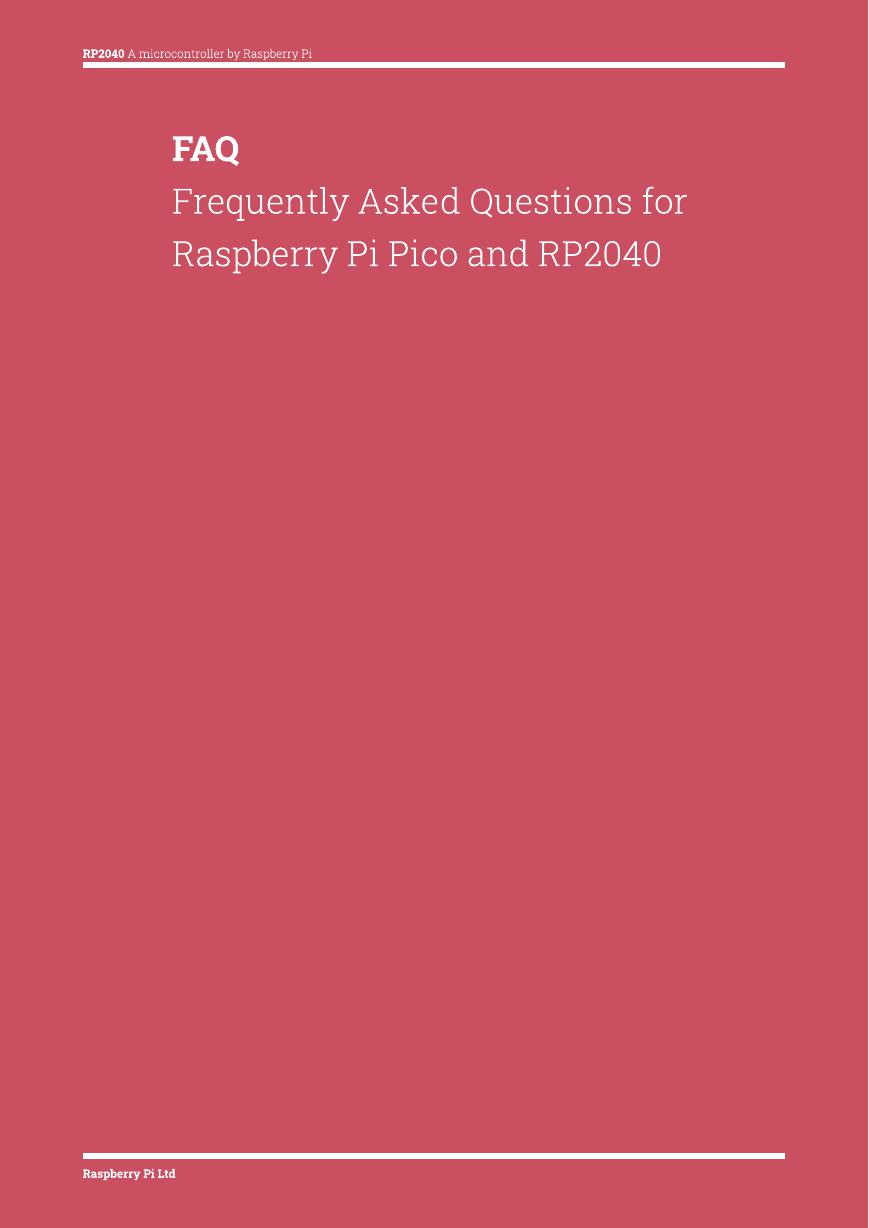
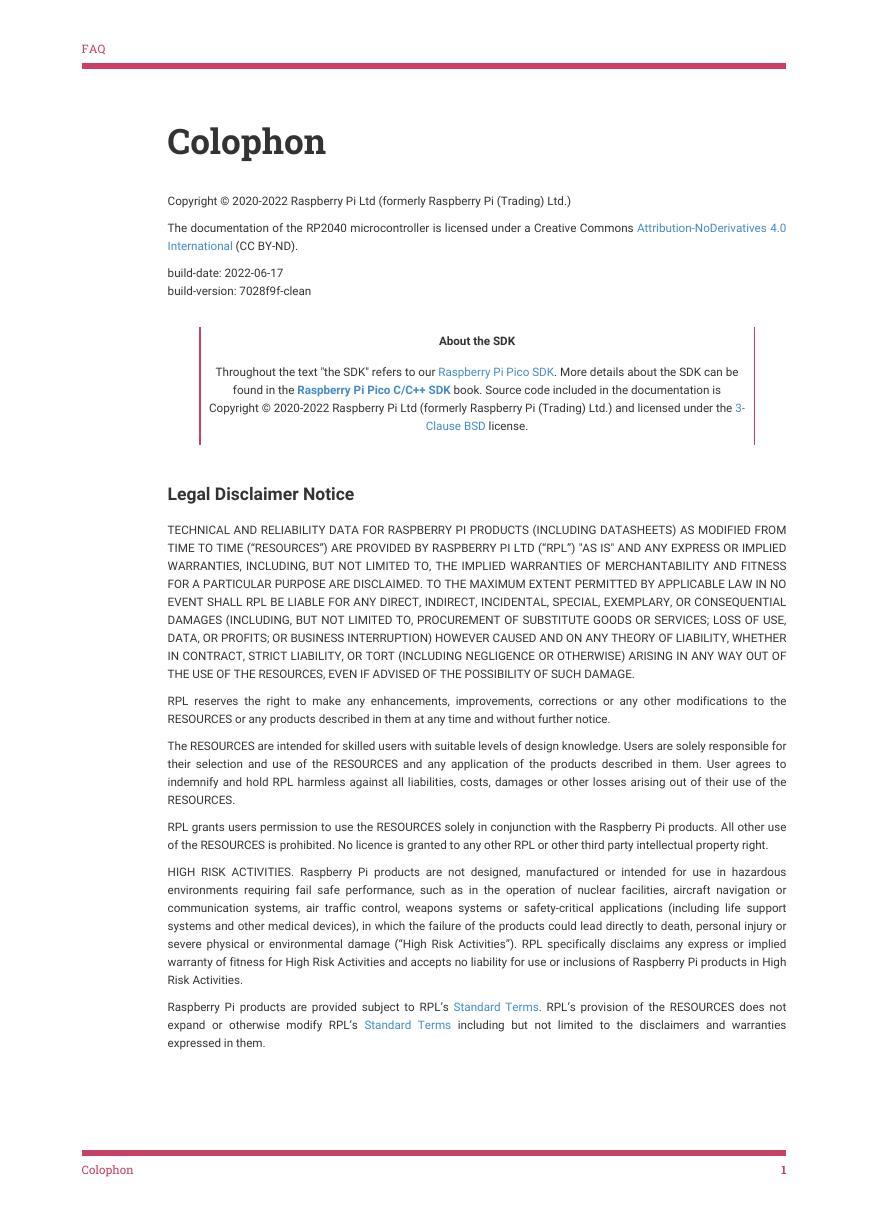


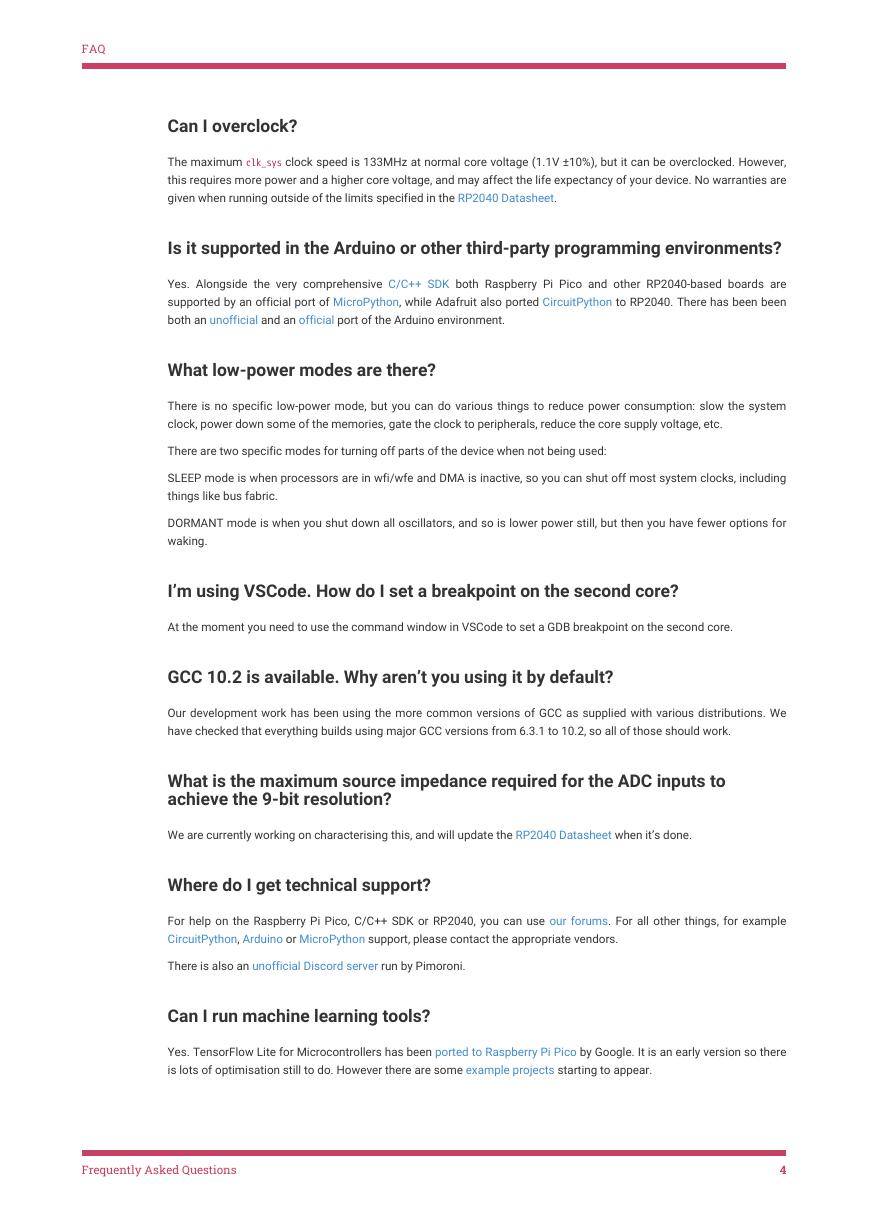
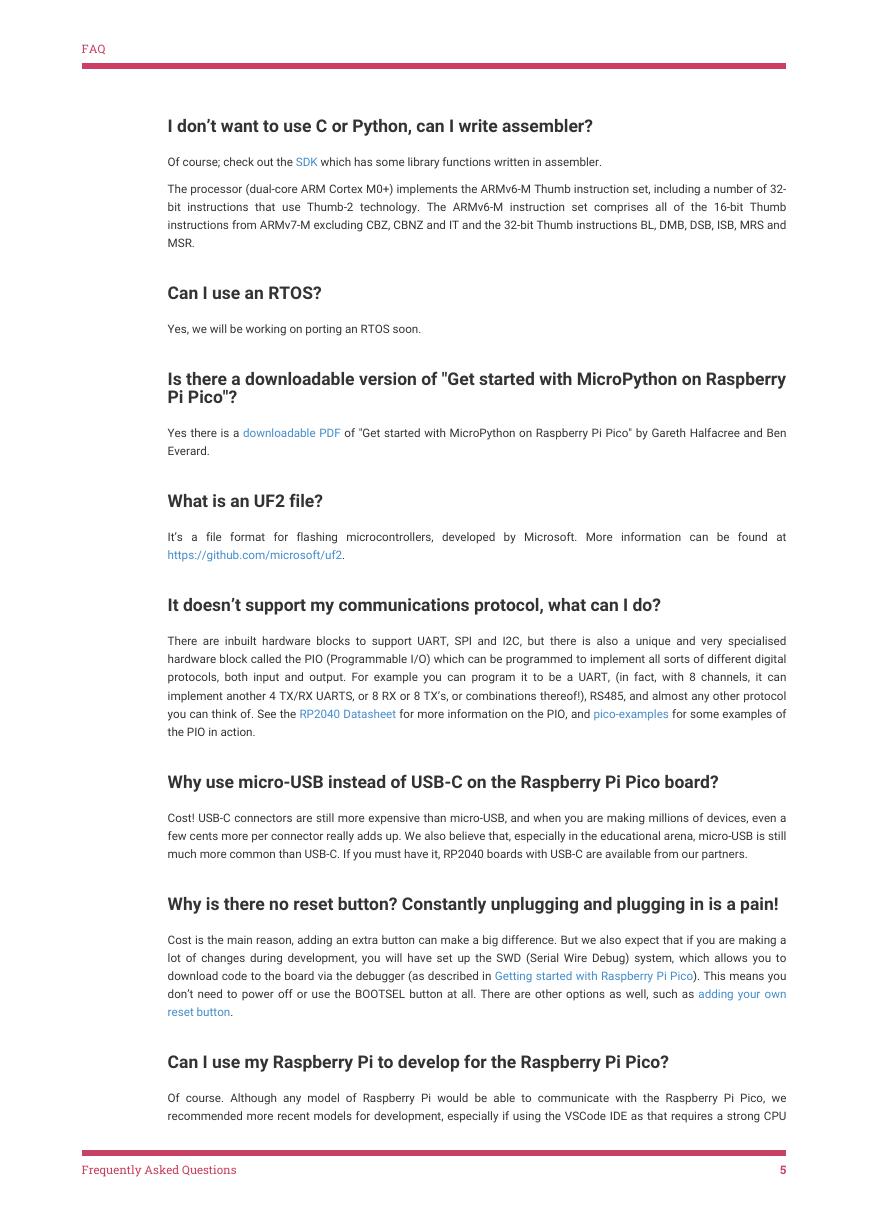

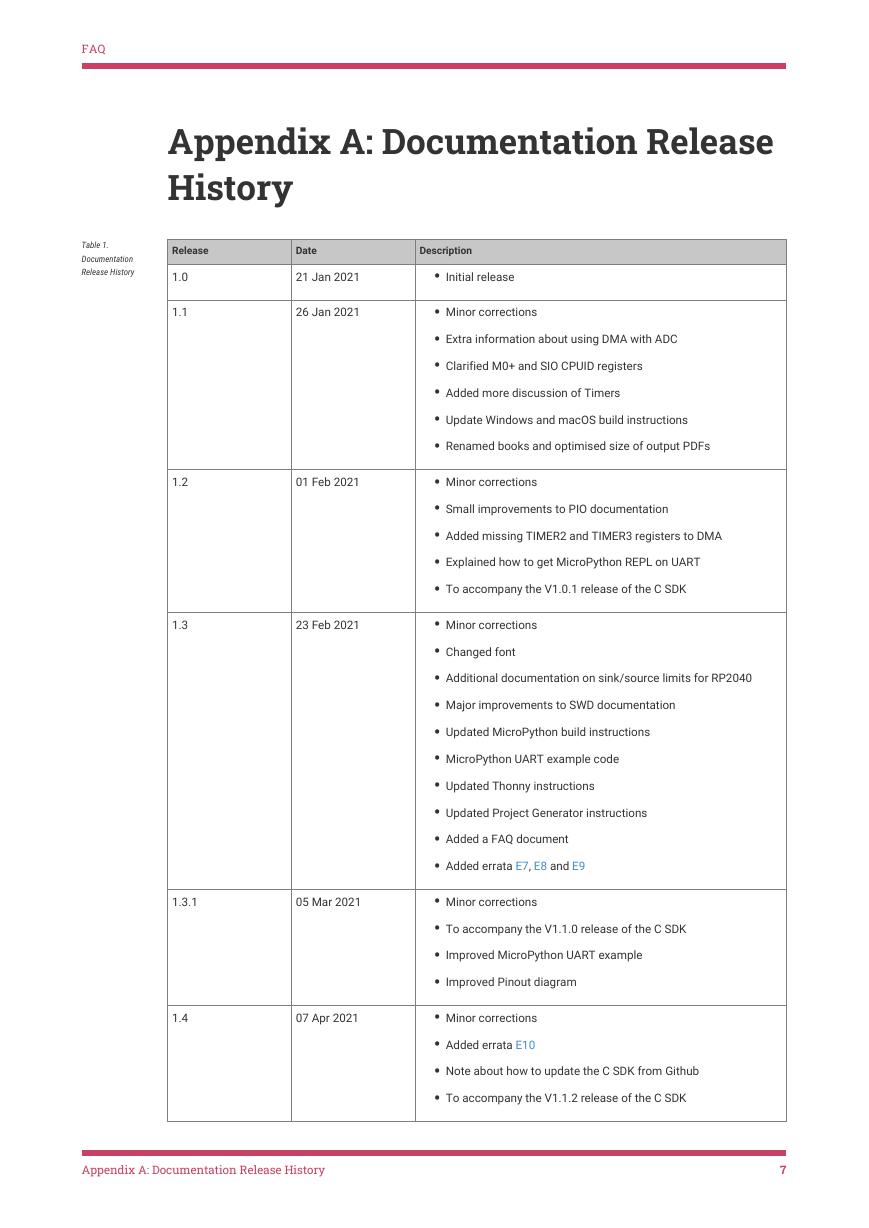








 V2版本原理图(Capacitive-Fingerprint-Reader-Schematic_V2).pdf
V2版本原理图(Capacitive-Fingerprint-Reader-Schematic_V2).pdf 摄像头工作原理.doc
摄像头工作原理.doc VL53L0X简要说明(En.FLVL53L00216).pdf
VL53L0X简要说明(En.FLVL53L00216).pdf 原理图(DVK720-Schematic).pdf
原理图(DVK720-Schematic).pdf 原理图(Pico-Clock-Green-Schdoc).pdf
原理图(Pico-Clock-Green-Schdoc).pdf 原理图(RS485-CAN-HAT-B-schematic).pdf
原理图(RS485-CAN-HAT-B-schematic).pdf File:SIM7500_SIM7600_SIM7800 Series_SSL_Application Note_V2.00.pdf
File:SIM7500_SIM7600_SIM7800 Series_SSL_Application Note_V2.00.pdf ADS1263(Ads1262).pdf
ADS1263(Ads1262).pdf 原理图(Open429Z-D-Schematic).pdf
原理图(Open429Z-D-Schematic).pdf 用户手册(Capacitive_Fingerprint_Reader_User_Manual_CN).pdf
用户手册(Capacitive_Fingerprint_Reader_User_Manual_CN).pdf CY7C68013A(英文版)(CY7C68013A).pdf
CY7C68013A(英文版)(CY7C68013A).pdf TechnicalReference_Dem.pdf
TechnicalReference_Dem.pdf